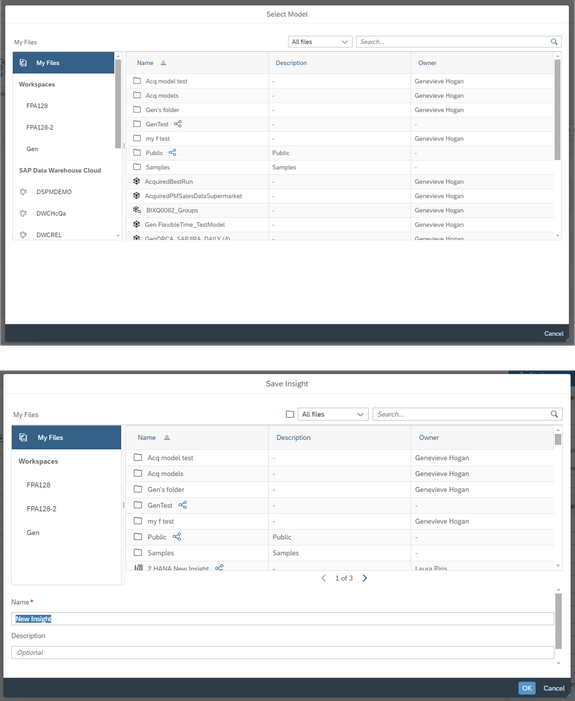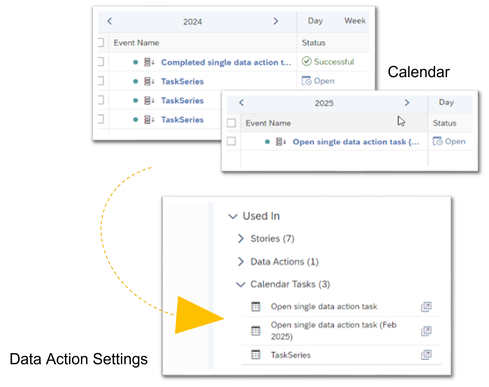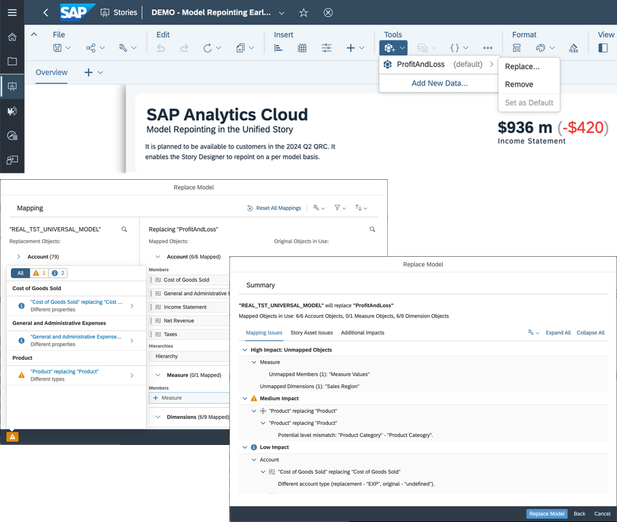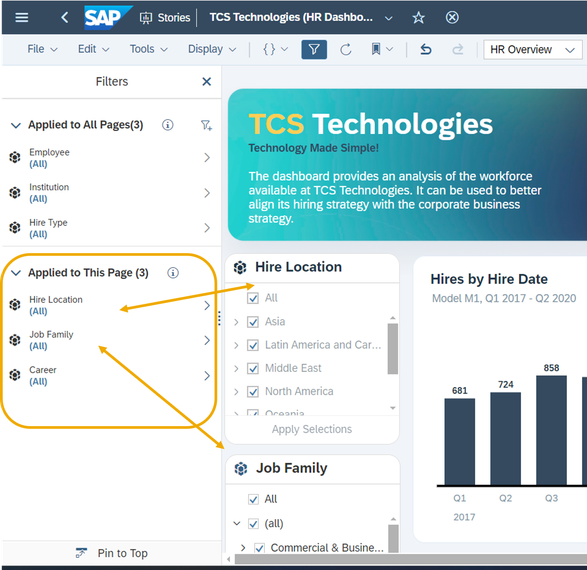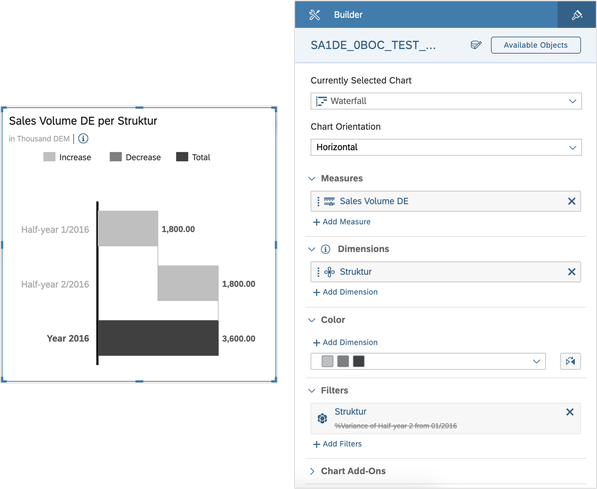
- SAP Community
- Products and Technology
- Technology
- Technology Blogs by SAP
- What’s New in SAP Analytics Cloud Release 2024.06
- Subscribe to RSS Feed
- Mark as New
- Mark as Read
- Bookmark
- Subscribe
- Printer Friendly Page
- Report Inappropriate Content
SAP Analytics Cloud brings together analytics and planning with unique integration to SAP applications and seamless access to heterogenous data sources. It helps everyone in your organization make decisions without doubt with trusted insights and integrated plans.
This blog post introduces the features of the SAP Analytics Cloud 2024.06 release available for SAP Analytics Cloud FastTrack customers. For SAP Analytics Cloud Quarterly Release Cycle (QRC) customers, this release and its features will be available as part of the QRC Q2 2024 release. View the QRC release schedule here.
System Administration
Although not required, you may upgrade to the latest SAP Analytics Cloud agent version 1.0.399 to take advantage of all data acquisition types. The agent’s minimum version remains at 1.0.75, with the following exceptions:
- Version 1.0.99 for SAP ERP/SQL Database
- Version 1.0.365 for SAP universe (UNX). The SAP Analytics Cloud agent requires additional setup steps, for more details see SAP Note 3262098
- Version 1.0.353 for SAP Business Warehouse (BW)
- Version 1.0.235 for SAP HANA View
- Version 1.0.248 for File Server
For more information, see System Requirements and Technical Prerequisites.
Regarding supported features and required updates for the integration of SAP BW with SAP Analytics Cloud, refer to SAP Note 2541557 for further details.
Regarding supported features and required updates for live universe access through SAP BusinessObjects Live Data Connect with SAP Analytics Cloud, refer to SAP Note 2771921 for further details.
Please download the latest version of the Simple Deployment Kit from Service Marketplace.
Note: To avoid downloading older versions and potentially exposing users to a vulnerable bundling of the Cloud Connector with SAPJVM, or Apache Tomcat, only the three latest versions of the kits are available to download.
For Cloud agent version change management details, refer to SAP Note 3264839.
Release Highlights
- Data Exploration
- Support workspace in data analyzer | (SAP Road Map Explorer)
- Export to PDF using fit to page width in Data Analyzer | (SAP Road Map Explorer)
- Data Modeling
- Provision of the “unit” property type | (SAP Road Map Explorer)
- Turn on Optimized Scenario Composer of Analytical Engine
- Enterprise Planning
- Data Actions - Show Calendar Usages of a Data Action
- Planning Trigger – updated formatting options formats | (SAP Road Map Explorer)
- Story Design
- Replace a Model in the Optimized Story Experience | (SAP Road Map Explorer)
- Access both story and page filters from the vertical Filter Panel
- Support for waterfall chart based on an SAP BW two-structure
- Add hyperlinks to the text in the chart title and footer
Data Exploration
Support workspace in data analyzer
In data analyzer it is now possible to open a model from workspaces, save insights to workspaces and reopen them from a workspace. Users can also open data analyzer from a chart or table in story that uses a model saved to a workspace. (SAP Road Map Explorer)
Export to PDF using fit to page width in Data Analyzer
When exporting data as a PDF file in the data analyzer, there is a new “Fit to page width” option which allows customers to resize a table to the actual page width for the PDF export. (SAP Road Map Explorer)
Data Modeling
Provision of the “unit” property type
Introducing new property type “Unit” which is available for dimensions of type Generic and Organization. The property has a maximum length of 127 characters and can be selected at Measure to indicate Unit of Measure.
Like for currencies, unit properties can be added to dimensions. If a measure has a Unit property assigned, MDS can make sure that aggregation does not happen with mixed Units (prevention of wrong results). (SAP Road Map Explorer)
Turn on Optimized Scenario Composer of Analytical Engine
The new query processing engine, “Use Optimized Scenario Composer of Analytical Engine” will be used by default for all models in SAP Analytics Cloud as of wave 2024.6, as part of a global migration to SAP HANA Cloud Platform. This engine will automatically be rolled out during a system update. If needed, in urgent cases, the engine can be reverted to the legacy engine, as long as your tenant has not been migrated.
For more information, see Optimized Scenario Composer for Analytical Engine.
Enterprise Planning
Data Actions - Show Calendar Usages of a Data Action
In Data Action Settings, users can see where a data action is used in other operations or applications, such as in stories, multi actions, or analytic applications. With this release, we have included calendar tasks in the “Used In” section of a data action. Only calendar tasks that are in an unfinished state are included. Additionally, this is only supported for single tasks and task series, not single tasks of a task series.
Planning Trigger – updated formatting options
It is now possible to set and save default styling preferences for planning triggers in the Themes Preferences dialog. Additionally, vector format such as SVG can be used in planning triggers. For each planning trigger’s styling panel, styling options can be restored to the default preferences, and the styling of the trigger button and font can be reset to default respectively.
This allows for more convenient and streamlined control over default styling when centrally managing the planning triggers’ appearance. (SAP Road Map Explorer)
Story Design
Replace a Model in the Optimized Story Experience
With this release, we the optimized story experience supports model replacement. It will be on a per model basis and the replacement model must be of the same data source type, same number, and type of structure dimensions (it does not have to be on the same connection or have the same number of objects). The original model and replacement model do not need to share the same connection nor have the same number of objects (accounts, measures, dimensions, or properties). However, the version of the replacement model must be the same or higher than the version of the original model. (SAP Road Map Explorer)
There are some data models that can only be used as the original model and not the replacement model. The following are examples of original and allowable replacement models:
- Analytic Dataset in SAP Datasphere can be changed to an Analytic Model in SAP Datasphere
Classic Account Model can be changed to the New Model Type with an Account Dimension
- Public Dataset can be changed to the New Model Type without an Account Dimension
Learn more in this blog post by Tunir Kapil.
Access both story and page filters from the vertical Filter Panel
It is now possible to view and interact with story and page filters from the vertical filter bar. For each input control on the current page, a page filter is displayed in the new “Applied to this Page” section on the vertical filter panel. It will update accordingly when navigating to another page.
Please note this is only available in the vertical filter panel.
Support for waterfall chart based on an SAP BW two-structure
With the Waterfall Chart, we now support SAP BW Models with a 2nd Structure. There are certain conditions that must be met to view data:
- Single measure and a single value filter on the secondary structure will result in a single bar unless there is a hierarchical measure.
- Multiple measures and a single value filter on the secondary structure will result in each measure being a bar and the data is based on the secondary structure filter.
- Single measure and multiple secondary structure members will result in each member of the secondary structure would be either increasing or decreasing with the last node as the total.
Limitations:
- Cannot change the order of the secondary structure members.
- If there is at least one hierarchical node, the expand/collapse function will be disabled.
Add hyperlinks to the text in the chart title and footer
For existing stories that are converted from the Classic Experience, the Hyperlink on the Chart Title and Footer is now maintained.
Option to define multiple hyperlinks on the Chart Title and Footer (identical to Text Widget).
Pass External Filter Context with Page and Story Hyperlink is supported. However, the option to “Only Apply Selected Dimension” is hidden for Chart Title and Footer.
Note that the hyperlink on the chart title will convert a dynamic title to static to maintain the hyperlink.
Additional resources:
This blog post only provides a high-level overview of the latest features and enhancements of SAP Analytics Cloud. You can find more details on these features in your In-App Help Guide for FastTrack customers and see this SAP Knowledge Base Article if you’d like to learn more about FastTrack and Quarterly Release Cycle releases.
If you have any questions regarding the content in this blog post, you can comment below. If you have product specific or technical questions, post a question to our SAP Analytics Cloud Questions & Answers forum. Visit our SAP Analytics Cloud Community pages to find more product information, best practices, and more. And check out our SAP Road Map Explorer to see more upcoming features of SAP Analytics Cloud.
You must be a registered user to add a comment. If you've already registered, sign in. Otherwise, register and sign in.
-
ABAP CDS Views - CDC (Change Data Capture)
2 -
AI
1 -
Analyze Workload Data
1 -
BTP
1 -
Business and IT Integration
2 -
Business application stu
1 -
Business Technology Platform
1 -
Business Trends
1,658 -
Business Trends
93 -
CAP
1 -
cf
1 -
Cloud Foundry
1 -
Confluent
1 -
Customer COE Basics and Fundamentals
1 -
Customer COE Latest and Greatest
3 -
Customer Data Browser app
1 -
Data Analysis Tool
1 -
data migration
1 -
data transfer
1 -
Datasphere
2 -
Event Information
1,400 -
Event Information
67 -
Expert
1 -
Expert Insights
177 -
Expert Insights
301 -
General
1 -
Google cloud
1 -
Google Next'24
1 -
GraphQL
1 -
Kafka
1 -
Life at SAP
780 -
Life at SAP
13 -
Migrate your Data App
1 -
MTA
1 -
Network Performance Analysis
1 -
NodeJS
1 -
PDF
1 -
POC
1 -
Product Updates
4,577 -
Product Updates
346 -
Replication Flow
1 -
REST API
1 -
RisewithSAP
1 -
SAP BTP
1 -
SAP BTP Cloud Foundry
1 -
SAP Cloud ALM
1 -
SAP Cloud Application Programming Model
1 -
SAP Datasphere
2 -
SAP S4HANA Cloud
1 -
SAP S4HANA Migration Cockpit
1 -
Technology Updates
6,873 -
Technology Updates
429 -
Workload Fluctuations
1
- SAP BW/4 - revamp and true to the line 2024 in Technology Blogs by Members
- SAP Fiori for SAP S/4HANA - Empowering Your Homepage: Enabling My Home for SAP S/4HANA 2023 FPS01 in Technology Blogs by SAP
- Composite Data Source Configuration in Optimized Story Experience in Technology Blogs by SAP
- Top Picks: Innovations Highlights from SAP Business Technology Platform (Q1/2024) in Technology Blogs by SAP
- What’s New in SAP Analytics Cloud Release 2024.08 in Technology Blogs by SAP
| User | Count |
|---|---|
| 33 | |
| 17 | |
| 15 | |
| 13 | |
| 11 | |
| 9 | |
| 8 | |
| 8 | |
| 8 | |
| 7 |
